 (main
trailhead
(main
trailhead  ),
OpenStreetMap
),
OpenStreetMap 

 (main
trailhead
(main
trailhead  ),
OpenStreetMap
),
OpenStreetMap 

Photos from the Marsh Trail and from vantage points along the
Huron River:

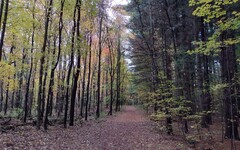
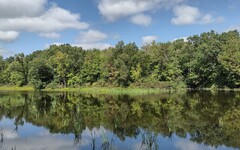
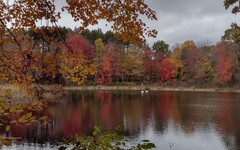
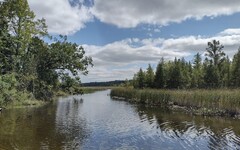
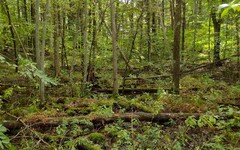
Photos from the Red & Blue Trails:
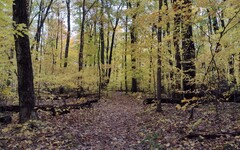
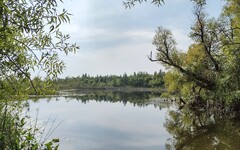

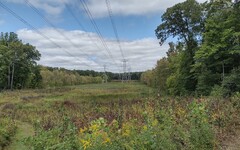



Overview:
The Proud Lake Recreation Area has a network of easy-going hiking trails
that pass through a beautiful combination of woods and waterways.
Highlights include trail segments along the Huron River and around a
pond that is frequented by waterfowl. There is also a spur trail leading to
Proud
Lake  .
.
Most of the hiker-only trails are on the east side of Wixom Road. There you will find numerous options, including three loops: the Marsh Trail and the overlapping Red and Blue Trails. West of Wixom there are several multi-use trails for hikers, equestrians and mountain bikers. Cutting across both sides of Wixom is the Chief Pontiac Trail, a point-to-point hiking trail that runs parallel to the Huron River on the east side, through the fishing/picnic area at Marker 24[*] near Wixom Road, followed by a long gentle ascent on the way to Old Plank Road at the western boundary of the park.
[*] The marker locations are shown on the above trail maps.
Leashed dogs are allowed on the hiking trails, but bikes and horses are not.
Be aware that hunting (in season) is allowed in the park, although there is a no hunting zone that encompasses the parts of the hiking trails that are east of Wixom Road and south of the Huron River. This includes the Marsh Trail but not the Red and Blue Trails.
On your first visit to Proud Lake, you will probably want to explore some
combination of the Red, Blue, and Marsh Trails. Starting out from the
main hiking trailhead  near the park headquarters off Wixom Road, you have the option of heading
north, east, or south.
near the park headquarters off Wixom Road, you have the option of heading
north, east, or south.
The south option leads to the Marsh Trail, which loops around a scenic
pond offering views that can occasionally be
spectacular  .
Although you might expect from its name that the Marsh Trail would be one
of the likeliest places for encountering mud, it tends to be relatively dry.
Most of the trail sits well above the level of the pond.
.
Although you might expect from its name that the Marsh Trail would be one
of the likeliest places for encountering mud, it tends to be relatively dry.
Most of the trail sits well above the level of the pond.
Hiking north and west from there via Markers 4 and 8 to Marker 9 will
take you to a bridge across the Huron with additional
captivating
views  .
On the other side of the Huron, you will find the overlapping Red and
Blue Trails. The latter is a 3 mile loop that has a shortcut across the
middle that connects Markers 13 and 17. Hiking the 1.8 mile Red Trail
amounts to following the Blue Trail, but taking the shortcut.
.
On the other side of the Huron, you will find the overlapping Red and
Blue Trails. The latter is a 3 mile loop that has a shortcut across the
middle that connects Markers 13 and 17. Hiking the 1.8 mile Red Trail
amounts to following the Blue Trail, but taking the shortcut.
The Blue Trail offers a worthwhile side trip to
Proud
Lake  at Marker 15.
If you are traversing the loop counterclockwise, after you pass through
Marker 13 heading east you will end up
out in
the open
at Marker 15.
If you are traversing the loop counterclockwise, after you pass through
Marker 13 heading east you will end up
out in
the open  while passing underneath some high voltage power lines.
The trail forks here, with the left branch continuing eastbound
through Marker 14. Instead you should take the right branch as it
follows the power lines south before bending back to the east and
into the woods. After a short distance through the woods, you will
emerge at Marker 15, where a boat launch for Proud Lake is located.
while passing underneath some high voltage power lines.
The trail forks here, with the left branch continuing eastbound
through Marker 14. Instead you should take the right branch as it
follows the power lines south before bending back to the east and
into the woods. After a short distance through the woods, you will
emerge at Marker 15, where a boat launch for Proud Lake is located.
From Marker 15, walk north along the boat launch access road for 0.65
miles to Marker 16 and the resumption of your Blue loop. This walk is
likely to be
pleasant  -- the access road is unpaved and has minimal traffic.
-- the access road is unpaved and has minimal traffic.
On MapPedometer, I have saved a route map for
a basic 5.8 mile hike  that follows the above directives and uses a segment of the Chief Pontiac
Trail to return to the trailhead.
that follows the above directives and uses a segment of the Chief Pontiac
Trail to return to the trailhead.
*
The trail segment connecting Markers 2 and 20 has a beautiful
stand of
red pines  that were planted in the 1930s as part of the
WPA
that were planted in the 1930s as part of the
WPA  .
More of these pines line the main entrance to the park off of Wixom.
.
More of these pines line the main entrance to the park off of Wixom.
*
On your way to Marker 15 and Proud Lake on the Blue Trail, there is another
fork in the trail  at the point where you turn east (left) into the woods.
The right branch of this fork is a 0.2 mile spur that continues further
south underneath the power lines, ending at the shore of Proud Lake. The
wide-open
view
at the point where you turn east (left) into the woods.
The right branch of this fork is a 0.2 mile spur that continues further
south underneath the power lines, ending at the shore of Proud Lake. The
wide-open
view  here is superior to what is available from Marker 15.
here is superior to what is available from Marker 15.
*
On the Red/Blue Trail between Markers 17 and 19,
a new 0.4 mile section of the Chief Pontiac Trail opened up in 2022.
It is shown on the OpenStreetMap, but not on the trail maps.
While the existing Red/Blue Trail stays in the woods adjacent to
wetlands, the new trail runs farther north in
open
fields  dotted with trees. Look for
trail markers
blazed with the CPT logo
dotted with trees. Look for
trail markers
blazed with the CPT logo  at the entry points about 0.15 miles west of Marker 17 and 0.3
miles east of Marker 19.
at the entry points about 0.15 miles west of Marker 17 and 0.3
miles east of Marker 19.
Hiking north from the main trailhead:
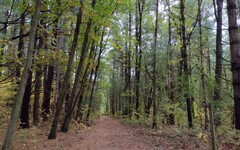
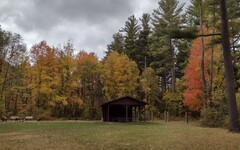
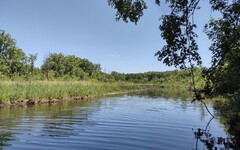
*
North of the main trailhead are the Upper and Lower Pines
Organizational Campgrounds. Assuming they are not in use, it is
worthwhile to include a side trip into this area on your hike.
A 0.8 mile round trip from the parking lot to Markers 22, 23, the
Lower Pines
Camp  , and the
picnic/fishing
area
, and the
picnic/fishing
area  at Marker 24 will provide some
great
views
at Marker 24 will provide some
great
views  of the Huron River.
of the Huron River.


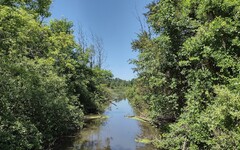
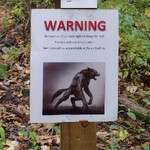
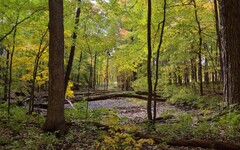
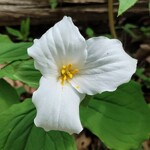
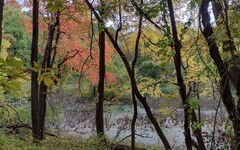
The multi-use trail network west of Wixom Road provides another
option for putting together an outstanding day hike. Possible starting
points for such a hike include the
mountain
bike staging area  at Marker A where Childs Lake Road and East Dawson Road meet,
or the small parking area on the shoulder of Garden Road near Marker J.
My preference is to use the
parking lot
at Marker A where Childs Lake Road and East Dawson Road meet,
or the small parking area on the shoulder of Garden Road near Marker J.
My preference is to use the
parking lot  for the
picnic/fishing
area
for the
picnic/fishing
area  at Marker 24 on the east side of Wixom Road. This location has the
advantage that it offers an easy side trip to the previously
mentioned Upper and Lower Pines campgrounds.
at Marker 24 on the east side of Wixom Road. This location has the
advantage that it offers an easy side trip to the previously
mentioned Upper and Lower Pines campgrounds.
If you are starting your hike from Marker 24, follow the
access road southwest to Wixom Road. Across Wixom you will see a
sign  that marks the Chief Pontiac Trail -- this is your entry point into the
west side trail network. A few paces beyond that, you will come to the
first of many forks in the trail. The left branch continues the CPT while
the right branch offers a tempting detour through a
pine
forest
that marks the Chief Pontiac Trail -- this is your entry point into the
west side trail network. A few paces beyond that, you will come to the
first of many forks in the trail. The left branch continues the CPT while
the right branch offers a tempting detour through a
pine
forest  to a nearby canoe livery. The detour rejoins the CPT shortly before the
trail crosses Garden Road headed south to Marker K.
to a nearby canoe livery. The detour rejoins the CPT shortly before the
trail crosses Garden Road headed south to Marker K.
Navigating the CPT:
At Marker K, the CPT turns to the west and passes through Markers M and D.
On the M-to-D segment, the trail
emerges from
the woods  into a broad open field with some marshy areas and
Norton
Creek
into a broad open field with some marshy areas and
Norton
Creek  flowing through the middle of it. There is a dilapidated
hiker-only
bridge
flowing through the middle of it. There is a dilapidated
hiker-only
bridge  that crosses the creek here, and the trail on either side of the
bridge can be muddy at times, or even
flooded
that crosses the creek here, and the trail on either side of the
bridge can be muddy at times, or even
flooded  .
If it seems impassable when you arrive at this point,
the only other way across the creek that doesn't involve getting wet
is to detour north to a
second
bridge
.
If it seems impassable when you arrive at this point,
the only other way across the creek that doesn't involve getting wet
is to detour north to a
second
bridge  near the horse staging area at Marker H. (I've saved a copy of the route on
MapPedometer
near the horse staging area at Marker H. (I've saved a copy of the route on
MapPedometer  .)
This detour adds about 0.7 miles to the hiking distance from M to D.
.)
This detour adds about 0.7 miles to the hiking distance from M to D.
About 150 yards beyond Marker D, the CPT veers to the south and begins
a long gentle climb through dense woods, gaining 200 feet in elevation
on the way to Markers E and F. On the D-to-E segment, the trail crosses
Childs Lake Road and enters a maze of intersecting mountain bike and
equestrian trail segments. Much of the complexity here is due to the
2022 addition of a new, twistier version of Loop 4 optimized for
mountain bikers (shown in blue on the
OpenStreetMap  ).
With equestrians continuing to follow the old version of Loop 4,
the bikes and horses are now less likely to interfere with each other.
).
With equestrians continuing to follow the old version of Loop 4,
the bikes and horses are now less likely to interfere with each other.
For map readers, it is unfortunate that the reconfiguration of the trails in the Loop 4 area is ongoing and the OpenStreetMap has not been able to keep up with the changes. Trail Markers E, F, and G are still in place and the signage in those locations provide the most reliable information. Also useful are the orange plastic trail markers for the CPT that make it easier to stay on that track. On the other hand, there are numerous trail crossings that provide essentially no information other than whether bikes or horses are allowed.
On MapPedometer, I've saved a
route map  that follows the current configuration of the CPT for 2.2 miles from
Marker 24 through Markers K, M, D, E, and F. The route ends a short
distance beyond F at a
crossing
that follows the current configuration of the CPT for 2.2 miles from
Marker 24 through Markers K, M, D, E, and F. The route ends a short
distance beyond F at a
crossing  where the CPT exits the Loop 4 area on its way to Old Plank Road
at the park's western boundary. If you want to keep going, the CPT
continues on the other side of Old Plank along a 2.1 mile connecting
trail that leads to Kensington Metropark.
where the CPT exits the Loop 4 area on its way to Old Plank Road
at the park's western boundary. If you want to keep going, the CPT
continues on the other side of Old Plank along a 2.1 mile connecting
trail that leads to Kensington Metropark.
Adding some equestrian or mountain bike trail segments to the mix:
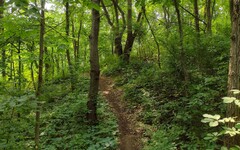
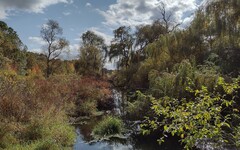
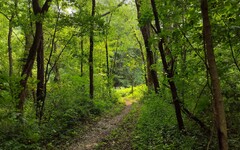
Of course you may complete the above CPT hike by retracing your steps.
On the other hand, if you are unfazed by the need to stay out of the way
of bikes and horses (and
werewolves  ),
there are plenty of options for further exploration of the area west of
Norton Creek on your return. Some suggestions:
),
there are plenty of options for further exploration of the area west of
Norton Creek on your return. Some suggestions:
* Starting from the end of the outbound route, this
3.5 mile return  continues west on the CPT across Old Plank Road and then north
on a section of the Kensington connecting trail
for about 0.3 miles through some beautiful
woods and
wetlands
continues west on the CPT across Old Plank Road and then north
on a section of the Kensington connecting trail
for about 0.3 miles through some beautiful
woods and
wetlands  .
The next stage follows an equestrian trail back across Old Plank Road
into the Loop 4 area at Marker G. From there, one should follow the
equestrian trail markers that point the way to Marker A (or follow the
new version of Loop 4 if you prefer a much longer and twistier mountain
bike route). After arriving at A, the route continues east to Marker D,
re-crosses the railroad tracks, and turns north to the equestrian
staging area at Marker H and the
second
bridge
.
The next stage follows an equestrian trail back across Old Plank Road
into the Loop 4 area at Marker G. From there, one should follow the
equestrian trail markers that point the way to Marker A (or follow the
new version of Loop 4 if you prefer a much longer and twistier mountain
bike route). After arriving at A, the route continues east to Marker D,
re-crosses the railroad tracks, and turns north to the equestrian
staging area at Marker H and the
second
bridge  across
Norton
Creek
across
Norton
Creek  . The final stages involve
passing through Markers I and J on the way back to Marker 24.
You can trim 0.4 miles off of the route by omitting the
pine forest detour at the finish.
. The final stages involve
passing through Markers I and J on the way back to Marker 24.
You can trim 0.4 miles off of the route by omitting the
pine forest detour at the finish.
* Another option to consider for your return is this
3.9 mile route  .
It departs northbound from the CPT on an equestrian trail and heads
directly to Marker A. From there, it continues to Marker B and turns
left (west) to enter Loop 3. This area has an interesting variety of
terrain, including
woodsy
hills
.
It departs northbound from the CPT on an equestrian trail and heads
directly to Marker A. From there, it continues to Marker B and turns
left (west) to enter Loop 3. This area has an interesting variety of
terrain, including
woodsy
hills  ,
open fields, and a
picnic table
on a summit
,
open fields, and a
picnic table
on a summit  .
Note that as of 2023, the trail
network in this area has been redesigned in a way similar to Loop 4 -- a new
loop optimized for mountain bikers has been installed side-by-side with
the old Loop 3. For the best hiking experience you'll probably want to
stay with the equestrians on the old loop. Fortunately, the
OpenStreetMap
.
Note that as of 2023, the trail
network in this area has been redesigned in a way similar to Loop 4 -- a new
loop optimized for mountain bikers has been installed side-by-side with
the old Loop 3. For the best hiking experience you'll probably want to
stay with the equestrians on the old loop. Fortunately, the
OpenStreetMap  appears to be accurate here, and there is ample signage in place to
help keep you on track. The route I've suggested takes a shortcut midway
through the loop and exits eastbound near Marker C, crosses the railroad
tracks, and joins Loop 2 southbound on its way to the horse staging area.
The return from there follows the same route as the previous one:
H to I to J to 24. Again, you can trim off 0.4 miles by omitting
the pine forest finish.
appears to be accurate here, and there is ample signage in place to
help keep you on track. The route I've suggested takes a shortcut midway
through the loop and exits eastbound near Marker C, crosses the railroad
tracks, and joins Loop 2 southbound on its way to the horse staging area.
The return from there follows the same route as the previous one:
H to I to J to 24. Again, you can trim off 0.4 miles by omitting
the pine forest finish.
For an alternative route that completely avoids the Loop 4 maze
and the hiker's bridge on the M-to-D segment, consider this
5.75 mile loop  .
Highlights include an exploration of the hills and
hollows
.
Highlights include an exploration of the hills and
hollows  in the northern half of Loop 3, and a series of
small
ponds
in the northern half of Loop 3, and a series of
small
ponds  ,
woods and
open
terrain
,
woods and
open
terrain  along the most attractive part of Loop 2.
along the most attractive part of Loop 2.
Directions: Head north on US-23 to eastbound I-96, exiting at Milford Road (Exit 155). Turn left (north) onto Milford then right (east) to Pontiac Trail after 0.35 miles. Continue east on Pontiac Trail for 4.2 miles to Wixom Road. Turn left onto North Wixom. After 2.5 miles North Wixom appears to end at a T-intersection. Continue on North Wixom by turning left (westbound) and follow it as it eventually turns north again.
The entrance to the park will be on your right (east). After entering, look for the main trailhead parking lot on your left after about 0.2 miles. If you are headed for the fishing/picnic area at Marker 24, you should instead continue northbound on Wixom for another 250 yards and look for the entryway on your right.
If traffic is light, driving time from North Main in Ann Arbor is about 35 minutes.
A Michigan
recreation passport  is required for vehicle entry.
is required for vehicle entry.
Excerpts from the website: Proud Lake Recreation Area, with more than 3,000 acres, is located on the scenic Huron River in Oakland County and offers diverse and plentiful recreational opportunities. More than 20 miles of trails cover several diverse habitats. During the winter months, skiers can enjoy seeing the evergreens draped with snow. In the spring, hepatica, marsh marigold, violets and many other wildflowers abound. Guided interpretive walks and other nature activities are offered.